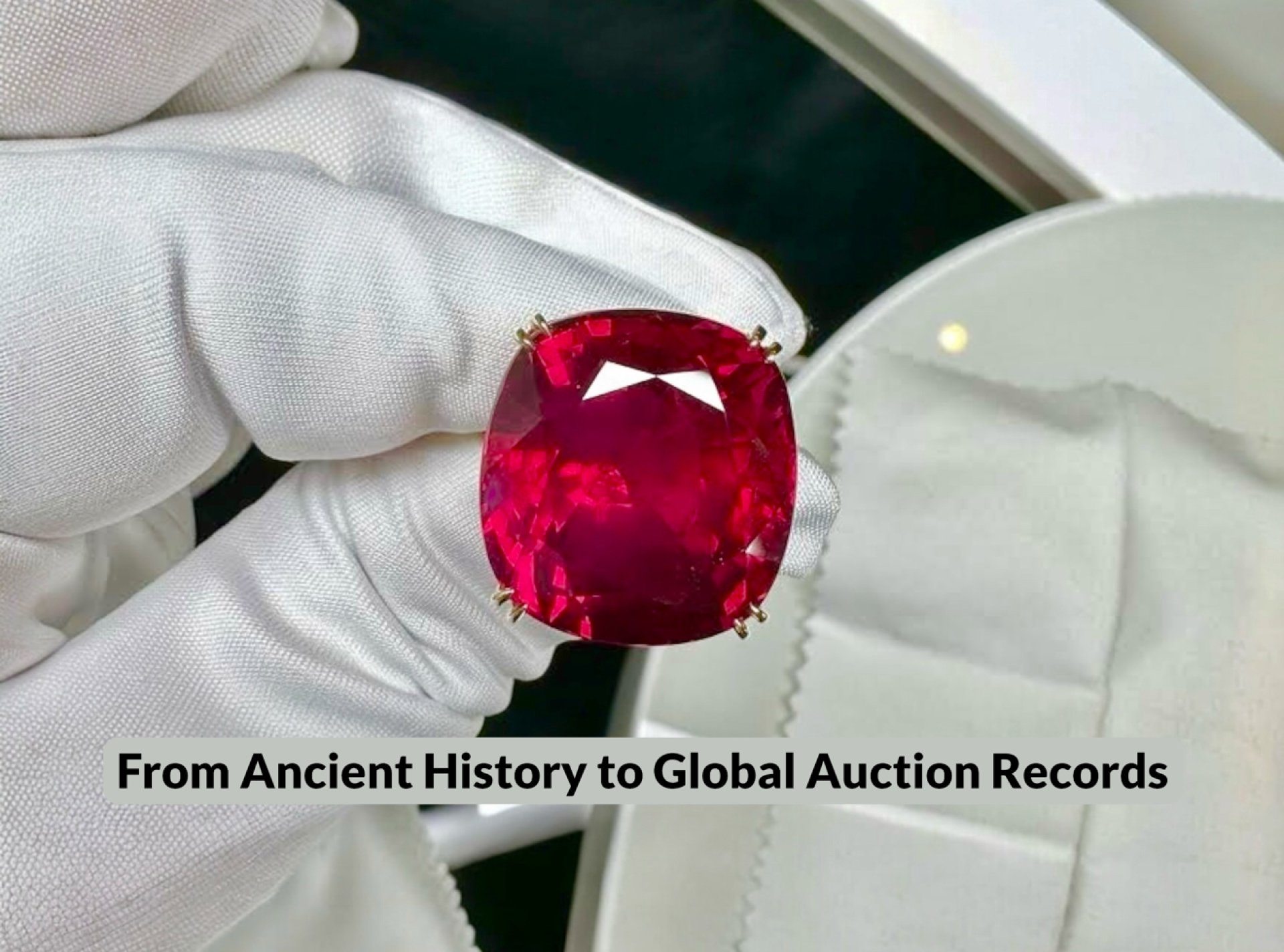Ruby: The King of Gemstones From Ancient History to Global Auction Records

Ruby: The King of Gemstones
From Ancient History to Global Auction Records
The Majesty of Ruby
In the world of gemstones, if diamond is hailed as the Queen of Gems, then ruby is rightfully crowned the King of Gems. Its allure lies not only in the vivid crimson that captures every gaze, but also in its rarity, its profound place in history, and its enduring symbolic power.
From ancient scriptures and royal legends to the treasures of emperors and kings, ruby has long been revered as a gem of strength, triumph, and supreme honor. And even after millennia have passed, ruby continues to reign on the global stagesetting record after record in the worlds most prestigious auctions.e.
Ruby in History and Culture
India Ancient Beliefs India was among the earliest civilizations to ascribe profound value to ruby. In the sacred texts Garuda Purana and Ratna Shastra, ruby is praised as Ratnaraj (रत्नराज), literally meaning King of Gems.
- > Possession of ruby was believed to bring wealth, courage, and authority.
> Ancient Indian kings adorned their crowns and weapons with rubies in ceremonial battles to enhance majesty and intimidate foes.
> Hindu scholars regarded ruby as the embodiment of Surya, the Sun God, who grants the power of life itself.
Burma The Legendary Origin Burma (Myanmar) lies at the heart of rubys legend, especially the famed Mogok Valley, often called the Valley of Rubies.
- > Burmese kings believed ruby conferred protection over life itself. Chronicles record that some warriors embedded rubies into their flesh, convinced they would become invincible in battle.
> The Burmese Pigeons Blood Ruby became the ultimate standard in the gem world, widely documented by Western travelers as early as the 16th century.
Siam The Treasure of Suvarnabhumi The ancient kingdom of Siam (Thailand) was also a renowned source of fine rubies, celebrated for their vivid colors, particularly from Chanthaburi and Trat.
- > Historical records note that Siamese rubies were presented to the Chinese imperial court as tribute.
> Within Siams royal court, ruby was among the Crown Jewels, used in coronation ceremonies as a mark of supreme sovereignty.
> During the 18th19th centuries, British and French merchants actively purchased Siamese rubies, transporting them to Europes markets.
China A Symbol of Prosperity and Power By the 13th15th centuries, rubies had entered China via the Silk Road. They were set into imperial regalia, ceremonial attire, and aristocratic ornaments such as ruby-studded belts and hairpins, representing vitality and prosperity.
- > Bright red rubies were associated with Yangthe life force and auspicious energy.
> Historical records confirm that rubies from Siam and Burma were imported into China from the Ming to Qing dynasties.
Europe A Symbol of Power and Passion In medieval Europe, ruby was regarded as a sacred stone believed to shield its bearer from harm. By the 11th12th centuries, ruby had become exceedingly rare and precious across the continent, imported through Venetian trade routes and the Byzantine Empire. It quickly rose to prominence as the most coveted gem within the regalia of kings and emperors.
- > French Crown Jewels: The French monarchy adorned their crowns and royal attire with rubies, signifying the grandeur and prosperity of the empire.
> Russian Imperial Collection: The Romanov dynasty treasured large rubies within their state collection of diamonds and imperial jewels.
> The Victorian Era: Ruby emerged as a gem of love and ardent passion, often fashioned into engagement rings and tokens of devotion.
The Middle East Jewel of Sultans and Empires In the Islamic world and ancient Persia, ruby was revered as a symbol of prosperity, divinity, and royal authority.
- > Sultans and caliphs amassed collections of magnificent rubies within their treasuries.
> Rubies were set into swords, coronation regalia, and even ceremonial armor, serving as emblems of supreme power and sovereignty.
Ruby in the Global Auction Market
As centuries passed, many royal treasures found their way into the global auction marketwhere natural Burmese rubies, in particular, have become the undisputed stars. These gems are valued not only for their rarity and beauty but also for their historical provenance, often linked to noble or royal collections.
Estrela de Fura A 55.22-carat Pigeons Blood ruby from Mozambique, which made history at Sothebys New York, Magnificent Jewels on June 8, 2023. It achieved a record-breaking USD 34.8 million (approx. THB 1.12 billion), making it the most expensive ruby ever sold at auction.
The Sunrise Ruby A 25.59-carat Burmese Pigeons Blood ruby from Mogok, which fetched USD 30.42 million at Sothebys Geneva in 2015. This sale marked one of the most significant milestones in ruby auction history.
The Graff Ruby An 8.62-carat Burmese ruby, sold in Geneva in 2014 for USD 8.6 million, setting a then-record price per carat for rubies.
The Hope Ruby A 32.08-carat Burmese ruby, sold at Christies Geneva in 2012 for USD 6.7 million, further cementing Burmese rubies as the pinnacle of gemstone desirability.
The Rosser Reeves Star Ruby A remarkable 138.7-carat star ruby, now housed in the Smithsonian Institution. Though never sold at auction, it remains one of the most famous star rubies in the world.
Ruby as an Investment
Price Stability Over the past three decades, the value of fine-quality rubies has shown a consistent upward trend. In particular, natural, unheated rubiesstones that have not undergone heat treatmentare exceedingly rare and command premium prices at market.
Sustained Demand Strong demand from Asia and the Middle East continues to fuel the market, ensuring that ruby remains one of the most desirable colored gemstones for collectors and investors alike.
Valuation Certification from world-renowned gemological institutes such as GIA, SSEF, Gübelin, and GRS significantly influences pricing, offering both credibility and confidence in the gems provenance and quality.
Symbolic Value Beyond its financial worth, ruby carries a timeless aura of luxury, honor, and prestigequalities that make it not only a secure investment, but also a personal treasure of enduring significance.
At global auction houses such as Sothebys and Christies, natural rubies weighing over 20 carats have repeatedly fetched prices in the millions of dollars per stoneclear proof of their rarity, desirability, and enduring value.
Conclusion
Ruby embodies every element of greatnesshistory, culture, gemological excellence, and record-breaking value. From the legendary Mogok Valley of Burma to the glittering auction stages of Geneva and New York, ruby continues to reign supreme as the true King of Gems.
For collectors, ruby is not merely a gemstone; it is a living record of history, a legacy that transcends generations, and a treasure that continues to set new benchmarks in the worlds most prestigious auctions.
 ATHITHAN
ATHITHAN